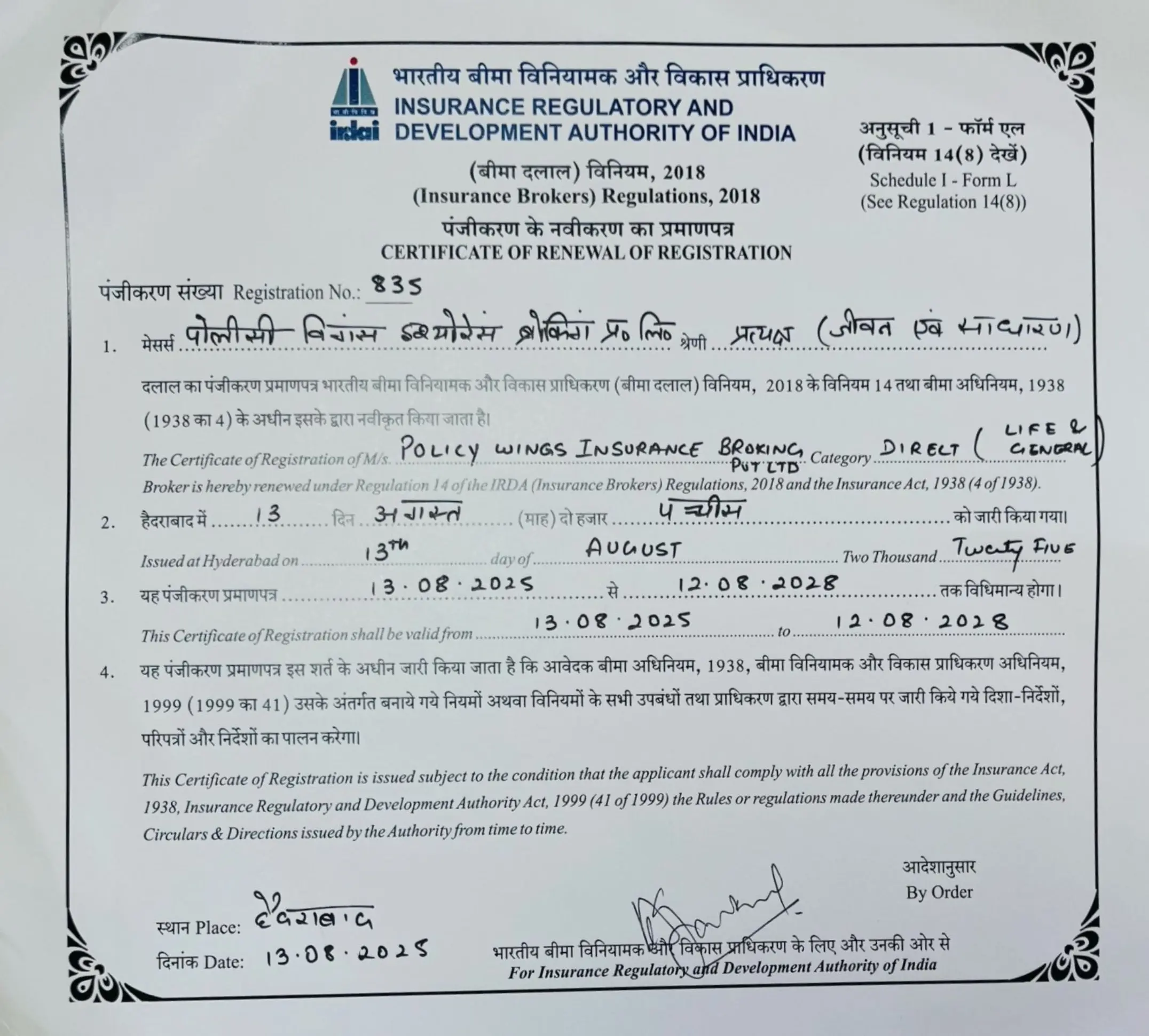Individual Health Insurance
Individual Health Insurance
Even a short visit to a hospital for a couple of days can set you back financially by a considerable margin. And it is no secret that the cost of medical care is always on the rise. Failing to take adequate precautions can leave you vulnerable to such expenses. Choosing a health insurance plan can be one of the most sensible options.
Another alternative is to save as much as you can. Yet even a minor surgery or hospitalisation for a few days can wipe away all these savings. A health insurance plan, on the other hand, will ensure that you are not burdened with the thoughts of expenses while seeking medical attention. Here is all that you need to know about an individual health insurance plan.
What is individual health insurance?
The lack of a health insurance plan can set you back financially in the case of a medical emergency. For individuals, these expenses can be a lot. This is where an individual health insurance plan can come in handy.
An individual health insurance plan offers coverage against medical expenses for a single person or an individual, thus the name. You can buy the plan for yourself, your spouse, your child, or your parents. Insurance providers consider a number of factors such as medical history, age, gender, etc. for determining the insurance premium for the policy.
A comprehensive individual plan will protect you against most medical contingencies. However, you can further improve the plan’s coverage by opting for add-ons by paying a small premium amount. It is one of the most effective ways to buy individual health insurance plans.
Types of individual health insurance plans available in India

This plan is ideal for individuals, spouses, children, and parents. Being a comprehensive plan, it offers protection against most medical conditions.

Treatment of crucial illnesses such as cancer, kidney failure, paralysis, etc. can be quite expensive. A critical care plan will safeguard you from such expenses.

This plan is ideal for individuals who are above 60 years old. The plan is also comprehensive in nature and offers coverage for most requirements. Insurance providers might require a comprehensive health checkup before issuing the policy.
How does an individual health insurance policy work?
Wondering how a health insurance policy works? It all starts with you choosing an individual health insurance plan. To choose a plan, you can decide on various factors such as coverage on offer, premiums, pre-existing conditions allowed, waiting periods, etc.
As per the policy and the insurance provider, the coverage for pre-existing conditions will differ. It is crucial that you keep a close eye on the coverage.
Based on the details provided by you, the insurance provider will calculate the insurance premium. Some insurance providers require you to undergo a full-body checkup before issuing a plan. Post this, the insurance provider will issue the policy. You must pay the premium decided by the insurer every year and in return, you will receive a sum insured or maximum amount of coverage.
Once the policy is issued, and you want to avail of the benefits, you will need to file a claim for it. The claims can either be cashless or reimbursement-based. Should you opt for cashless claims, the insurance provider will directly settle the bill with the hospital. On the other hand, in reimbursement claims, you must pay for the expenses out of your pockets and file for reimbursement, where the insurer will compensate the expenses.
In the event, that you do not file a claim, there are two possibilities. Some insurance providers offer a no-claim bonus, which is essentially a discount on the premium paid. While other insurance providers offer to increase the sum insured for the policy if no claims are made.
Features and benefits of individual health insurance
Choosing to add a health insurance plan to your financial portfolio can be beneficial in quite a few ways. The following are some salient features of an individual health insurance plan.
1. Medical Coverage
The plan offers medical coverage for the insured. Depending on the terms and conditions of the policy, the insurance provider will pay a certain amount for medical expenses incurred by the insured.
2. Inclusions and exclusions
Like any other insurance plan, individual health insurance plans also have inclusions and exclusions. These are essentially the conditions where your policy is valid and when it is not.
3. Co-payment
Health insurance policies usually have a clause for co-payment. If your plan has such a clause, then you must bear a certain percentage of the medical expenses and the insurance provider will pay for the rest.
4. Add-ons
You can improve upon the coverage of the policy with the help of add-ons. By paying a small premium, you can add more features to the existing plan.
5. Renewal
Most of the health insurance plans come with lifetime renewability, ensuring that you have coverage for longer periods of time.
6. Pre and post-hospitalisation
Most insurance providers cover pre and post-hospitalisation expenses. This allows the insured to get ready and recover from medical treatment without worrying about additional expenses.
The following are some benefits of choosing an individual health insurance plan.
1. Medical expenses
The biggest benefit of opting for a health insurance plan is that the policy will cover your medical expenses. Considering the ever-increasing cost of medical care, it can be a massive factor in savings.
2. Tax benefits
When you buy an individual health insurance plan, you will end up paying premiums for the policy. And the premiums that you pay will give you a tax deduction under Section 80D.
3. Cashless services
Consider this, You undergo medical treatment at a hospital and walk away without having to pay anything or by paying minimal admission charges. This is possible if you have an individual health insurance plan and avail of cashless benefits.
4. Daily allowance
It is possible that the insured is admitted to a hospital for a few days. In such cases, insurance providers offer a daily allowance for each day the insured spends at the hospital. It can be particularly beneficial for the breadwinner of the family.
What is covered under individual health insurance plans?
On choosing an individual health insurance plan, you usually get access to the following coverages. It is important to note that the actual coverage might differ a bit, depending on the insurance provider and policy.
1. Inpatient expenses
The policy will cover expenses related to a patient who is admitted for more than 24 hours. Examples of expenses include ICU charges, room rent, nursing charges, drugs and medications, etc.
2. Pre and post-hospitalisation
The plan will cover expenses before admission to the hospital and even after discharge.
3. Ambulance charges
Plans cover the expenses related to ambulances during accidents or emergencies.
4. Daycare treatment
The policy will cover expenses related to medical procedures that require admission for less than 24 hours.
5. Preventive checkup
Insurance providers usually cover the changes related to a preventive health checkup of the insured.
6. Domiciliary treatment
If a doctor recommends the insured to undergo a treatment right from their homes, the expenses will be covered by the insurance provider.
What is not covered under individual health insurance plans?
While an individual health insurance plan covers a lot of expenses and scenarios, there are a few scenarios that are not covered.
1. Dental care treatment
2. Injuries related to nuclear perils or wars
3. Medical conditions due to drug or alcohol abuse
4. Injuries that are self-inflicted
5. Cosmetic treatment
6. Treatment of STDs such as HIV
7. Injuries or health hazards due to involvement in criminal activities
8. Experimental treatments are usually not covered
Are there any waiting periods under individual health insurance plans?
Yes, most health insurance plans have waiting periods for certain medical conditions. When you buy an individual health insurance plan, you must sail over the waiting period to file any claims for those medical conditions. Waiting periods are for very specific treatments or pre-existing conditions and the duration largely depends on the condition and insurance provider.
How to buy an individual health insurance policy online?
Fortunately, buying an individual health insurance plan is much easier than you might think. Here are a few simple steps to help you with the process.
1. Visit the website of your favourite insurance provider or insurance aggregator.
2. Look for the health insurance option from the catalogue.
3. Provide basic details of the insured such as age, gender, name, and contact information.
4. Inform the insurance provider or aggregator about any pre-existing medical conditions that you have.
5. Select a plan that offers adequate coverage and is within your budget.
6. Proceed with the premium payment of the policy.
7. Receive a digital copy of the insurance in your email ID within a few minutes.
How much individual health insurance coverage should you have?
The standard rule of thumb suggests that the sum insured by a health insurance plan should be half of your annual income. Given the rising medical expenses and the cost of some of the surgeries, a minimum sum insured of Rs. 10 lakhs is recommended.
Things to keep in mind while buying an individual health insurance policy
Before you set out to buy a health insurance plan, here are some things that you must keep in mind.
1. Policy requirements
Looking at your health requirements and buying a policy accordingly is essential. Keep a list of coverage that you would want in your policy, handy while choosing the plan.
2. Network hospitals
It is always a good idea to go through the network hospital list. Visiting a network hospital for treatment will allow you to avail of cashless benefits.
3. Sub-limits
Some insurance plans have sub-limits. These limits are essentially monetary caps on certain treatments, medical conditions, and diseases. Sub-limits can either be a specific amount or a percentage of the sum insured.
4. Premiums
Affordability of a plan is one of the most important factors in the decision-making process. It is important to look at the policy premium and coverage on offer, to help you decide whether to proceed with a plan or not.
5. Claims process
Another factor that you must look at before buying a policy is the claims process. Insurers who offer a simple claim settlement process will make it easier for you to live with the policy.
Tax benefits with individual health insurance policy
Buying a health insurance plan offers you tax deductions under Section 80D of the Income Tax Act. The upper ceiling for policy premiums is Rs. 25,000 for individual plans and Rs. 50,000 for senior citizen parents. In other words, a taxpayer can avail of tax deductions of Rs. 75,000 per year. If the insured and their parents are all senior citizens, the upper limit is set at Rs. 1 lakh per year.
Things to look at when buying individual health insurance plan
Here are a few other things that you must look at while buying an individual health insurance plan.
1. Inclusions and exclusions
Do not forget to go through the list of inclusions and exclusions of a health insurance plan. Overlooking the list can result in even claim rejections.
2. Waiting period
If you are looking for a specific cover, make sure to look at the waiting period for it. And if there is a waiting period, whether you are willing to wait for it to conclude. Waiting periods can range between a few months to a couple of years, depending on the condition.
3. Immediate diseases
Insurance plans do not cover illnesses within 30 days of buying the policy. Unless it is due to an accident.
4. Room rent
Insurance companies usually have a cap on the room rent. Make sure that you read the policy features in detail and are aware of any such caps.
5. Modern treatments
Another important aspect to check in your health insurance plan is the coverage of modern treatments. Since there are a lot of new types of surgeries available, such as robotic surgery, cyberknife, and even stem cell therapy, ensure that your policy covers these.
Documents required for individual health insurance
You would need the following set of documents to purchase an individual health insurance plan.
1. Proof of address
○ Driving licence
○ Rent agreement
○ PAN card
○ Passport
○ Aadhar Card
○ Utility bills
2. Proof of age
○ Birth certificate
○ Driving licence
○ Aadhar Card
○ PAN Card
○ Passport
3. Proof of identity
○ Driving licence
○ Passport
○ Voter ID
○ Aadhar Card
○ Passport size photographs
○ Application form filled out and signed
Individual health insurance claim process
There are two types of claims that you can opt for and the processes differ a bit based on them. And here are the steps.
Cashless
- You must reach out to the insurance desk of a network hospital and inform them about the intent to file a cashless claim.
- You will need to fill out the claim form either from the website of the insurance provider or from the insurance desk.
- The hospital will then send the estimate of the medical treatment along with other necessary documents to your insurance provider.
- Once the claim is approved, you can undergo the treatment.
- Before discharge, your insurance provider will directly settle the bill with the hospital.
Reimbursement
These steps are valid if you visit a non-network hospital for your medical treatment.
- The insured is admitted to the hospital and undergoes the necessary treatment by paying for the expenses.
- Post the hospitalisation phase, the insured can file a claim with the insurance provider.
- The insured will need to fill out the claims form and submit all the necessary documents such as bills, receipts, medical summary, reports, discharge summary, etc.
- Once the claim is approved, the insurance provider will submit the amount directly to your account.
Who should buy individual health insurance?
A lot of individuals can benefit from an individual health insurance plan. For example.
- Individuals looking for comprehensive coverage, rather than relying on floater policies.
- Individuals looking for additional coverage, apart from employer-provided health insurance plans.
- If other members of the family are already insured, it might be sensible to opt for an individual health plan.
- Individuals who have a greater risk of health hazards should have medical coverage.
- If you do not want to worry about the age limit when it comes to renewing the policy.
- It is for individuals who want to have a higher sum insured, as compared to the family floater plan.
Family health plan vs. individual health insurance
A family health plan offers coverage for each member of the family on a floater basis. While it offers coverage to each member, the sum insured is shared among all the members. Thus, multiple claims during a year can be a bit difficult. By paying a single premium, you can secure the policy for all the members of the family.
An individual health plan, on the other hand, requires a separate plan for each family member. Though the overall premium in such instances can be a bit high, they do offer better and higher coverage. For example, a family floater with a sum insured of Rs. 10 lakh will provide the same coverage for all the members. But an individual plan will offer Rs. 10 lakh coverage for each individual.
While family floaters can be more affordable, individual health insurance plans offer better coverage and sum insured.
How many claims are allowed in a year?
Most insurance providers do not have a cap on the number of times that you can file a claim. However, the amount of each of the claims is important. If the sum of all the claims exceeds the sum insured by the plan, the benefits will cease. Thus, you can file as many claims as you want to, as long as the total claim amount is less than the sum insured.
Is OPD benefit covered under individual health insurance?
OPD benefit or outpatient department benefit refers to medical treatment and consultations that do not require the patient to be admitted. These usually include doctor consultations, diagnostic tests, etc. Usually, OPD coverage is available as an add-on for individual health insurance plans.
To Sum Up!
An individual health insurance plan offers a lot of protection for an individual with and without any health issues. By investing in the plan, you can protect your finances in the future and even avail of tax benefits.
Frequently Asked Questions
Yes, you can choose add-ons for your individual health insurance plan during renewal. It will provide additional cover on top of the base cover.
Yes, you can. You can have group health insurance provided by your employer and choose another individual health insurance plan.
Individuals must be within the age limit of 18 and 65 years to buy an individual health insurance plan.
Leading Health Insurance Companies





Latest Blogs
Introduction While buying or renewing car insurance, you would surely come across two very common terms: Zero Depreciation and...
Introduction In India, getting insurance for your car is non-negotiable. With so many plans and so many add-ons available, it...
Introduction Everyone deserves healthcare but sadly, with the medical expenses rising so fast in India, not everyone can afford...
Introduction Do you think that buying life insurance means having to go through complicated policies and paperwork and paying...
Introduction You don’t buy a car insurance just fulfil a legal requirement. The repair costs have really increased, spare...
Introduction You can’t predict life but it’s always possible to secure the financial future of your family with life...
Introduction You have waited so long to finally purchase that car, saved for it and checked all those reviews....
Introduction Upon buying insurance, you will notice different short forms in your policy documents that might confuse you. One...









